| Listing 1 - 10 of 16 | << page >> |
Sort by
|
Article

Year: 2003
Abstract | Keywords | Export | Availability | Bookmark
 Loading...
Loading...Choose an application
- Reference Manager
- EndNote
- RefWorks (Direct export to RefWorks)
For a horse to succeed in a show-jumping career, the individual has to possess both excellent physical abilities as well as a suitable personality to perform under challenging conditions. Forty-one Dutch Warmblood horses were used to develop personality tests and correlations between test variables and early training performances in jumping were studied. In behavioural tests, during the first 2 years of the horses' lives, personality aspects like emotionality, reactivity to human and learning abilities were quantified. At the age of 3, horses were broken and received early training in show-jumping. The inter-relationship between several performance variables measured during this early training phase were studied using principal component analysis (PCA). Variables measured in the different personality tests (novel-object test, handling test, avoidance-learning test and a reward-learning test) showed no correlations, suggesting that these tests all triggered different aspects of a horse's personality. This study indicates that it is possible to predict a substantial part of the show-jumping performance of an individual horse later in life by personality traits earlier in life.
Ability. --- Age. --- Analysis. --- Association. --- Avoidance learning. --- Behavioural test. --- Emotionality. --- Handling. --- Horse. --- Horses. --- Human. --- Jumping. --- Learning ability. --- Learning-ability. --- Learning. --- Life. --- Performance. --- Personality. --- Physical. --- Principal component analysis. --- Reactivity. --- Test. --- Tests. --- Training.
Article
Year: 2003
Abstract | Keywords | Export | Availability | Bookmark
 Loading...
Loading...Choose an application
- Reference Manager
- EndNote
- RefWorks (Direct export to RefWorks)
To achieve optimal performance in equine sports as well as in leisure not only the physical abilities of the horse should be considered, but also the horse's personality. Besides temperamental aspects, like emotionality, or the horse's reactivity towards humans in handling situations, the learning ability of the horse is another relevant personality trait. To study whether differences in learning performance are consistent over time and whether individual learning performance differs between learning tests or is affected by emotionality, 39 young horses (Dutch Warmblood) were tested repeatedly in two learning tests. An aversive stimulus (AS) was used in one learning test (the avoidance learning test) and a reward was used in the other learning test (the reward learning test). During both learning tests behaviour as well as heart rate were measured. Each test was executed four times, twice when horses were 1 year of age, and twice when they were 2 years of age. Half of the horses received additional physical training from 6 months onwards. In both tests horses could be classified as either performers, i.e. completing the daily session, or as non-performers, i.e. returning to the home environment without having completed the daily session. There were some indications that emotionality might have caused non-performing behaviour, but these indications are not convincing enough to exclude other causes. Furthermore, there seem to be no simple relationships between measures of heart rate, behavioural responses putatively related to emotionality and learning performance. Horses revealed consistent individual learning performances within years in both tests, and in the avoidance learning test also between years. There was no significant correlation between learning performances in the avoidance learning test and the learning performances in the reward learning test. It is concluded that individual learning abilities are consistent over a short time interval for an avoidan
Ability. --- Age. --- Avoidance learning. --- Avoidance. --- Behaviour. --- Design. --- Emotionality. --- Environment. --- Equine. --- Handling. --- Heart rate. --- Heart-rate. --- Horse. --- Horses. --- Human. --- Humans. --- Learning ability. --- Learning-ability. --- Learning. --- Method. --- Performance. --- Personality. --- Physical. --- Reactivity. --- Response. --- Responses. --- Reward. --- Situations. --- Stimulus. --- Test. --- Tests. --- Time. --- Training. --- Young.
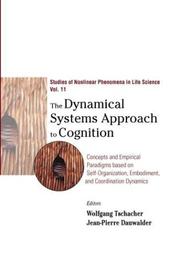
ISBN: 1281876798 9786611876791 981256439X 9812386106 9789812386106 9789812564399 Year: 2003 Publisher: River Edge, N.J. : World Scientific,
Abstract | Keywords | Export | Availability | Bookmark
 Loading...
Loading...Choose an application
- Reference Manager
- EndNote
- RefWorks (Direct export to RefWorks)
The shared platform of the articles collected in this volume is usedto advocate a dynamical systems approach to cognition. It is arguedthat recent developments in cognitive science towards an account ofembodiment, together with the general approach of complexity theoryand dynamics, have a major impact on behavioral and cognitivescience.
Cognition. --- Cognitive psychology. --- Self-organizing systems. --- Learning systems (Automatic control) --- Self-optimizing systems --- Cybernetics --- Intellect --- Learning ability --- Synergetics --- Psychology, Cognitive --- Cognitive science --- Psychology
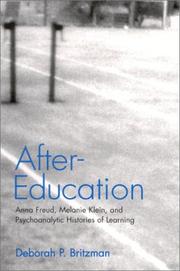
ISBN: 0791487156 1417500808 9781417500802 0791456749 9780791456743 0791456730 9780791456736 9780791487150 Year: 2003 Publisher: Albany : State University of New York Press,
Abstract | Keywords | Export | Availability | Bookmark
 Loading...
Loading...Choose an application
- Reference Manager
- EndNote
- RefWorks (Direct export to RefWorks)
In After-Education Deborah P. Britzman raises the startling question, What is education that it should give us such trouble? She explores a series of historic and contemporary psychoanalytic arguments over the nature of reality and fantasy for thinking through the force and history of education. Drawing from the theories of Anna Freud and Melanie Klein, she analyzes experiences of difficult knowledge, pedagogy, group psychology, theory, and questions of loneliness in learning education. Throughout the book, education appears and is transformed in its various guises: as a nervous condition, as social relation, as authority, as psychological knowledge, as quality of psychical reality, as fact of natality, as the thing between teachers and students, as an institution, and as a play between reality and fantasy.
Learning, Psychology of. --- Psychoanalysis and education. --- Learning --- Psychology of learning --- Educational psychology --- Comprehension --- Learning ability --- Education and psychoanalysis --- Education --- Psychological aspects --- Klein, Melanie. --- Freud, Anna, --- Klein, Melanie, --- Kurain, Meranī --- קליין, מלאני --- クライン メラニー --- Froid, Anah, --- פריוד, אנה
Article

Year: 2003
Abstract | Keywords | Export | Availability | Bookmark
 Loading...
Loading...Choose an application
- Reference Manager
- EndNote
- RefWorks (Direct export to RefWorks)
Human performance on diverse tests of intellect are impacted by a "general" regulatory factor that accounts for up to 50% of the variance between individuals on intelligence tests. Neurobiological determinants of general cognitive abilities are essentially unknown, owing in part to the paucity of animal research wherein neurobiological analyses are possible. We report a methodology with which we have assessed individual differences in the general learning abilities of laboratory mice. Abilities of mice on tests of associative fear conditioning, operant avoidance, path integration, discrimination, and spatial navigation were assessed. Tasks were designed so that each made unique sensory, motor, motivational, and information processing demands on the animals. A sample of 56 genetically diverse outbred mice (CD-1) was used to assess individuals' acquisition on each task. Indicative of a common source of variance, positive correlations were found between individuals' performance on all tasks. When tested on multiple test batteries, the overall performance ranks of individuals were found to be highly reliable and were "normally" distributed. Factor analysis of learning performance variables determined that a single factor accounted for 38% of the total variance across animals. Animals' levels of native activity and body weights accounted for little of the variability in learning, although animals' propensity for exploration loaded strongly ( and was positively correlated) with learning abilities. These results indicate that diverse learning abilities of laboratory mice are influenced by a common source of variance and, moreover, that the general learning abilities of individual mice can be specified relative to a sample of peers
Ability. --- Acquisition. --- Activity. --- Analysis. --- Animal. --- Animals. --- Avoidance. --- Body weight. --- Body-weight. --- Brain. --- Cognitive-ability. --- Conditioning. --- Demand. --- Discrimination. --- Enhancement. --- Exploration. --- Expression. --- Fear. --- Genetics. --- Human. --- Individual difference. --- Individual differences. --- Individual-differences. --- Intelligence,general intelligence,fluid intelligence,associative learning,memory,spatial learning,emotional learning,learning systems,genetic variation,behavioral phenotypes. --- Intelligence. --- Laboratory mice. --- Laboratory. --- Learning ability. --- Learning-ability. --- Learning. --- Level. --- Memory. --- Methodology. --- Mice. --- Navigation. --- Performance. --- Rank. --- Rat. --- Research. --- Sensory. --- Spatial. --- System. --- Task. --- Tasks. --- Test. --- Tests. --- Variability. --- Weight.

ISBN: 0786868449 Year: 2003 Publisher: New York : Hyperion,
Abstract | Keywords | Export | Availability | Bookmark
 Loading...
Loading...Choose an application
- Reference Manager
- EndNote
- RefWorks (Direct export to RefWorks)
Statistical physics --- Synchronization --- Self-organizing systems --- Synchronisation --- Systèmes auto-organisés --- Synchronization. --- Self-organizing systems. --- 124.1 --- #WSCH:AAS2 --- Learning systems (Automatic control) --- Self-optimizing systems --- Cybernetics --- Intellect --- Learning ability --- Synergetics --- Synchronism --- Time measurements --- Ordening. Chaos --- 124.1 Ordening. Chaos --- Systèmes auto-organisés
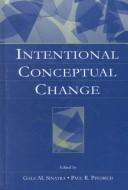
ISBN: 1135648921 1283708094 1282321757 9786612321757 1410606716 9781410606716 9780805838251 0805838252 0805838252 9781135648879 9781135648916 9781135648923 9781138972926 1135648913 9781283708098 9781282321755 661232175X Year: 2003 Publisher: Mahwah, N.J. L. Erlbaum
Abstract | Keywords | Export | Availability | Bookmark
 Loading...
Loading...Choose an application
- Reference Manager
- EndNote
- RefWorks (Direct export to RefWorks)
This volume brings together a distinguished, international list of scholars to explore the role of the learner's intention in knowledge change. Traditional views of knowledge reconstruction placed the impetus for thought change outside the learner's control. The teacher, instructional methods, materials, and activities were identified as the seat of change. Recent perspectives on learning, however, suggest that the learner can play an active, indeed, intentional role in the process of knowledge restructuring. This volume explores this new, innovative view of conceptual change learning u
Concepts. --- Change (Psychology) --- Learning, Psychology of. --- Intention. --- Attitude (Psychology) --- Learning --- Psychology of learning --- Educational psychology --- Comprehension --- Learning ability --- Concept formation --- Abstraction --- Knowledge, Theory of --- Perception --- Psychology --- Psychological aspects --- Concepts --- Intention --- Learning, Psychology of --- #PBIB:2003.3 --- #PBIB:2004.4 --- #PBIB:gift 2004 --- Change (Psychology).
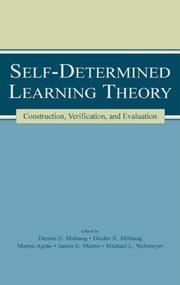
ISBN: 0805836985 1410606236 9781410606235 9780805836981 1135654441 113565445X 1282378880 9786612378881 9781135654405 9781135654443 9781135654450 9781138866805 Year: 2003 Publisher: Mahwah, N.J. : Lawrence Erlbaum Associates, Publishers,
Abstract | Keywords | Export | Availability | Bookmark
 Loading...
Loading...Choose an application
- Reference Manager
- EndNote
- RefWorks (Direct export to RefWorks)
This volume explains that self-determined learning theory is based on the claim that learning is adjustment. It does this by showing that a causal connection exists between opportunities to learn, engagement in those opportunities, adjustments to them, and learning.
Cognitive psychology --- Educational psychology --- Learning, Psychology of. --- Adjustment (Psychology) --- Autonomy (Psychology) --- Learning --- Psychology of learning --- Comprehension --- Learning ability --- Freedom (Psychology) --- Independence (Psychology) --- Self-determination (Psychology) --- Self-direction (Psychology) --- Dependency (Psychology) --- Ego (Psychology) --- Emotions --- Accommodation (Psychology) --- Adaptation (Psychology) --- Adapting behavior --- Adaptive behavior --- Coping behavior --- Maladjustment (Psychology) --- Personality --- Psychology --- Adaptability (Psychology) --- Psychological aspects
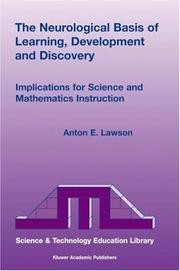
ISBN: 0306482061 1402011806 Year: 2003 Publisher: Dordrecht, Netherlands ; Boston, Massachusetts : Kluwer Academic Publishers,
Abstract | Keywords | Export | Availability | Bookmark
 Loading...
Loading...Choose an application
- Reference Manager
- EndNote
- RefWorks (Direct export to RefWorks)
A goal of mine ever since becoming an educational researcher has been to help construct a sound theory to guide instructional practice. For far too long, educational practice has suffered because we have lacked firm instructional guidelines, which in my view should be based on sound psychological theory, which in turn should be based on sound neurological theory. In other words, teachers need to know how to teach and that "how-to-teach" should be based solidly on how people learn and how their brains function. As you will see in this book, my answer to the question of how people learn is that we all learn by spontaneously generating and testing ideas. Idea generating involves analogies and testing requires comparing predicted consequences with actual consequences. We learn this way because the brain is essentially an idea generating and testing machine. But there is more to it than this. The very process ofgenerating and testing ideas results not only in the construction of ideas that work (i. e. , the learning of useful declarative knowledge), but also in improved skill in learning (i. e. , the development of improved procedural knowledge).
Education. --- Mathematics --- Science education. --- Science Education. --- Mathematics Education. --- Education, general. --- Learning & Instruction. --- Study and teaching. --- #PBIB:2003.2 --- Learning --- Learning, Psychology of. --- Physiological aspects. --- Learning, Psychology of --- Psychology of learning --- Physiological aspects --- Psychological aspects --- Mathematics—Study and teaching . --- Learning. --- Instruction. --- Neuropsychology --- Educational psychology --- Comprehension --- Learning ability --- Learning process --- Education --- Children --- Education, Primitive --- Education of children --- Human resource development --- Instruction --- Pedagogy --- Schooling --- Students --- Youth --- Civilization --- Learning and scholarship --- Mental discipline --- Schools --- Teaching --- Training --- Science education --- Scientific education
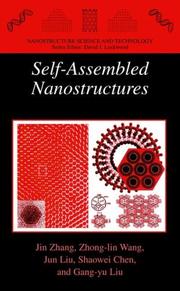
ISBN: 9780306472992 0306472996 9780306479410 0306479419 Year: 2003 Publisher: New York : Kluwer Academic/Plenum Publishers,
Abstract | Keywords | Export | Availability | Bookmark
 Loading...
Loading...Choose an application
- Reference Manager
- EndNote
- RefWorks (Direct export to RefWorks)
Nanostructures refer to materials that have relevant dimensions on the nanometer length scales and reside in the mesoscopic regime between isolated atoms and molecules in bulk matter. These materials have unique physical properties that are distinctly different from bulk materials. Self-Assembled Nanostructures provides systematic coverage of basic nanomaterials science including materials assembly and synthesis, characterization, and application. Suitable for both beginners and experts, it balances the chemistry aspects of nanomaterials with physical principles. It also highlights nanomaterial-based architectures including assembled or self-assembled systems. Filled with in-depth discussion of important applications of nano-architectures as well as potential applications ranging from physical to chemical and biological systems, Self-Assembled Nanostructures is the essential reference or text for scientists involved with nanostructures.
Nanostructures. --- Self-organizing systems. --- Nanostructures --- Systèmes auto-organisés --- Self-organizing systems --- Physics --- Physical Sciences & Mathematics --- Atomic Physics --- Physics. --- Inorganic chemistry. --- Physical chemistry. --- Condensed matter. --- Materials science. --- Condensed Matter Physics. --- Physical Chemistry. --- Inorganic Chemistry. --- Characterization and Evaluation of Materials. --- Chemistry, Physical organic. --- Chemistry, inorganic. --- Surfaces (Physics). --- Surface chemistry --- Surfaces (Technology) --- Inorganic chemistry --- Chemistry --- Inorganic compounds --- Chemistry, Physical organic --- Chemistry, Organic --- Chemistry, Physical and theoretical --- Material science --- Physical sciences --- Chemistry, Theoretical --- Physical chemistry --- Theoretical chemistry --- Condensed materials --- Condensed media --- Condensed phase --- Materials, Condensed --- Media, Condensed --- Phase, Condensed --- Liquids --- Matter --- Solids --- Learning systems (Automatic control) --- Self-optimizing systems --- Cybernetics --- Intellect --- Learning ability --- Synergetics --- Nanoscience
| Listing 1 - 10 of 16 | << page >> |
Sort by
|

 Search
Search Feedback
Feedback About
About Help
Help News
News